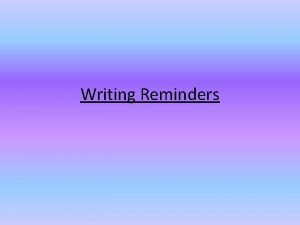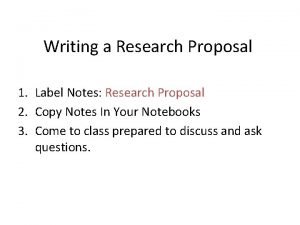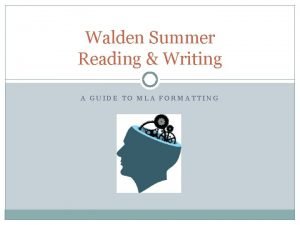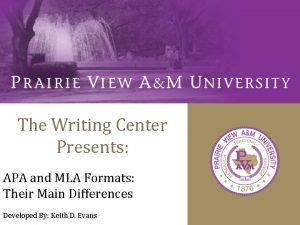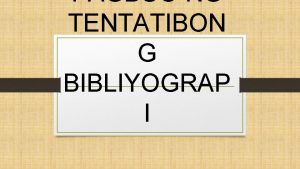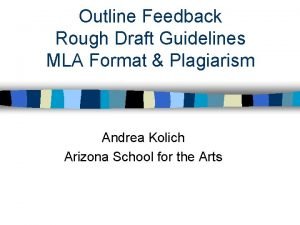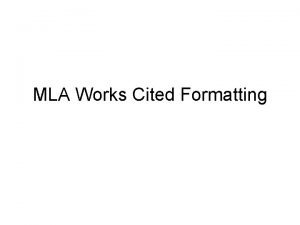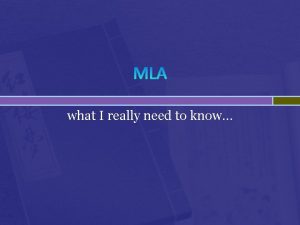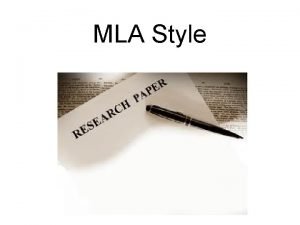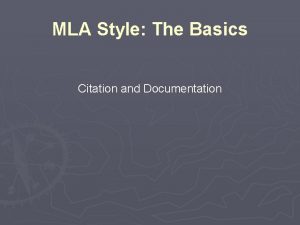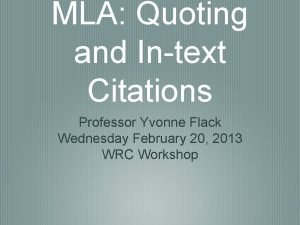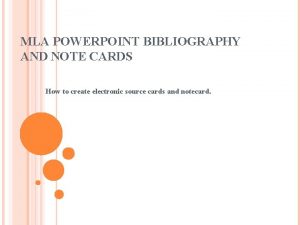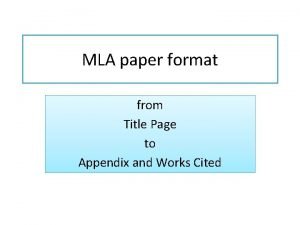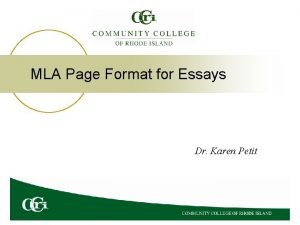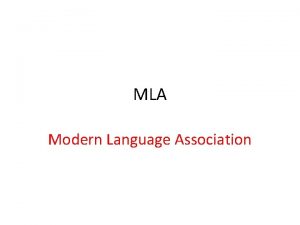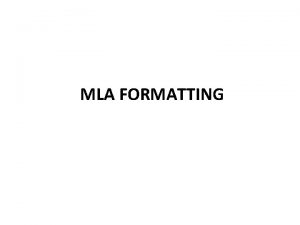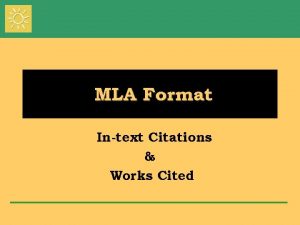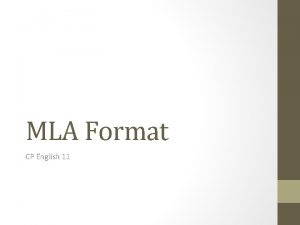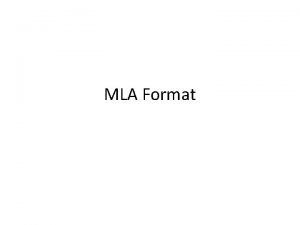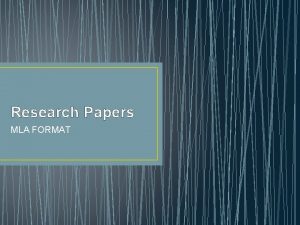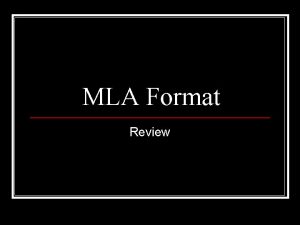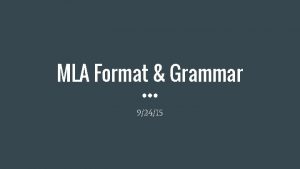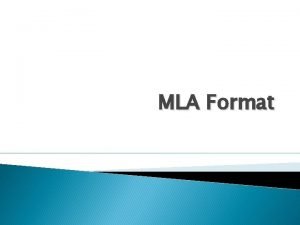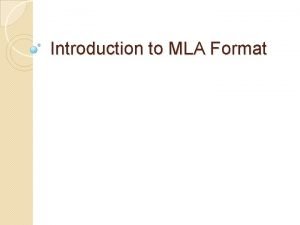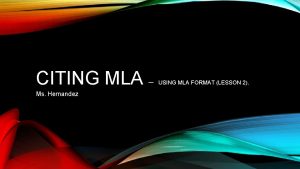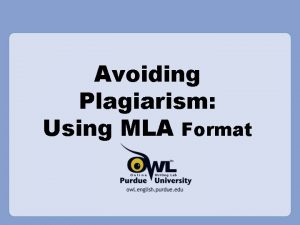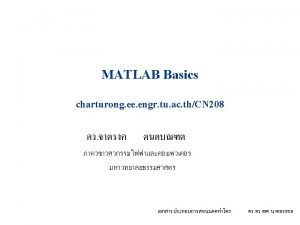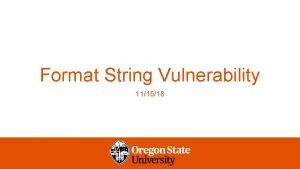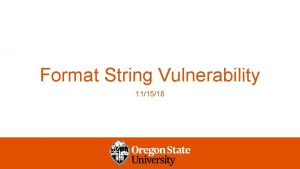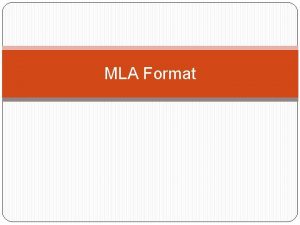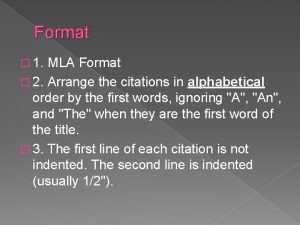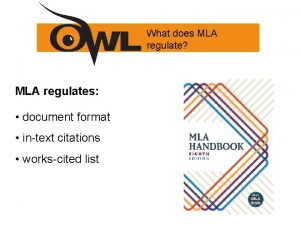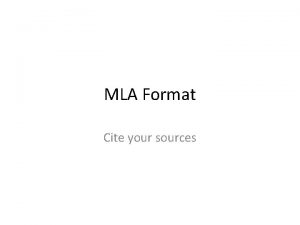Using MLA Format What is MLA MLA is




















- Slides: 20

Using MLA Format

What is MLA? MLA is a method of formatting papers that is primarily used for humanitiesbased courses. By using a MLA format, it helps writers give credit to the people whose work is being referenced in a standard way.

Basic Guidelines Type your paper on a regular sheet of paper, in a standard black font, like Times New Roman.

Basic Guidelines Do not make a title page for your paper, unless your teacher asks for one. On your first page, click insert, then page numbers, and choose “top of page” and “right”. If your teacher asks you not to number the first page, unclick the “start on first page” box.

Basic Guidelines Double space your paper. Go to “format”, and then click “paragraph”. Select double space. Create your heading. First type your name, then your teacher’s name, then the name of the class, and finally, the date (inverted). Check out the example on the next slide.

Heading Anita Knapp Mrs. Haskins English 9 22 January 2008

Basic Guidelines After heading your paper, on the next line (which is still double spaced), write your title. Do not underline, italicize, or write your title in all capital letters. On the next line (still double spaced), start typing your paper.

Finding Resources If there is a pathfinder for your class assignment, you can locate online resources by clicking the Class Links page of our Media Center webpage. Find your class, and click the link for “tried and true” web and book resources. If you are locating your own resources, make sure you are using reputable websites. This resource can help: http: //www. lib. berkeley. edu/Teaching. Lib/Gu ides/Internet/Evaluate. html

You need to document: Direct quotes, both entire sentences and phrases Paraphrases (rephrased or summarized material) Words specific or unique to the author's research, theories, or ideas Use of an author's argument or line of thinking Historical, statistical, or scientific facts Articles or studies you refer to within your text

In-text Citation In-text, or parenthetical citation, is when you reference someone else’s research in your paper. For example, in a paper about Harry Potter, if you paraphrase or quote something you read, you use the author’s last name and page number as the citation. Example: Some claim that the Harry Potter series is an allegory for Europe in the 1930’s (Develle 3).

Continued… Some claim that the Harry Potter series is an allegory for Europe in the 1930’s (Develle 3). In the example above, the idea from that sentence came from the 3 rd page of an article/book by Develle. Even though it isn’t a quote, it is still Develle’s idea and must be cited.

Using a direct quote If you are using a direct quote from an article in your paper, and your sentence includes the author’s name and book/article title, your citation needs to include only the page number: According to Dr. Deville, in his bestselling book Knowing Harry, “Voldemort is Hitler, Dumbledore is Churchill, and Potter is FDR's America ” (170).

Using direct quotes If you use a quote, and you don’t explain in your sentence who the author was, you have to cite with the author’s name and page number. Note that the punctuation FOLLOWS the citation. “It is clear that Voldemort is Hitler, Dumbledore is Churchill, and Potter is FDR's America in the Harry Potter series ” (Deville 170).

Works Cited Once your paper is written, you need to attach a list of references that you used, called a Works Cited page.

Works Cited Page

MLA style format for Works Cited For a book: Author’s last name, first name. Title of Book. City of Publication: Publishing company, publication date. For an article: Author. "Article. " Title of Publication Issue/Volume # (Date of Publication): page(s). For an online resource: Author. "Article. " Publication Title. Date of Publication. Retrieval date <web address>.

Book example (should be double spaced, with a hanging indent) Clawfed, Marilyn. America’s Richest People. Baltimore: Bel. Air, 1976. Jonessey, Vivian R. , and Martin O. Engle. Deaf History: Triumphs and Tragedies. Washington, DC: Deaf Club, 1989.

Article examples Note: If an article has no author, begin with the title Magazine Article Comptell, Augustine. "Are We So Beautiful? " Beauty Center 3 Dec. 1995: A 3. Newspaper Article Grosslyn, Jessica. "Plane Crash Raises Fears on Safety of Airplanes. " Philadelphia News 14 Feb. 1994: A 10, col. 3. Encyclopedia Article Krueber, Alfred L. "The Concept and Components of Cell Cultures. " Britannica: Micropedia. 1998 ed.

Online resource examples Online book Fuller, Jennifer. Cat Phobia. 1977. 18 Jan. 1999 <http: //books. university. edu/1020/phobia>. Online newspaper article Reid, T. R. "Druids Return to Stonehenge. " Washington Post 23 Nov. 1993. 25 Nov. 1993 <http: //www. washingtonpost. com/wp~srv/WPlate/1993 -11 -23/045 I-062298 idx. hmtl>. Online Article with no author "Fleeting Consciousness. " US News Online 29 June 1998. 25 October 1999 <http: //www. usnews. com/usnews/issue/980629/29 brain. html>.

Still need some help? Try the “citation machine”, at http: //citationmachine. net/, where you can type in your information, and it will provide the citation. NOTE: It will not double space or do a hanging indent, but it will put everything in the order, so make sure you finish formatting it properly before turning it in!
 Mla top left corner
Mla top left corner Introduction to research proposal
Introduction to research proposal Walden mla citation
Walden mla citation Mla format specifications
Mla format specifications Apa first page
Apa first page Halimbawa ng talasanggunian sa pananaliksik
Halimbawa ng talasanggunian sa pananaliksik Rough draft mla format
Rough draft mla format Owl works cited page
Owl works cited page Mla header
Mla header Whats mla format
Whats mla format Mla cover page
Mla cover page Mla citation poem
Mla citation poem Mla format note cards
Mla format note cards Examples of appendices
Examples of appendices 1 inch margin
1 inch margin Mla prefers times new roman font
Mla prefers times new roman font Paragraphs in mla format
Paragraphs in mla format Works cited page
Works cited page How to cite a website with no author mla
How to cite a website with no author mla What is a work cited page
What is a work cited page Mla citation
Mla citation
